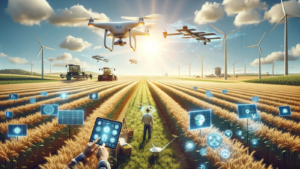
Source : Author’s creation with ChatGPT
As an R&D Innovation Manager, I am continually inspired by the groundbreaking solutions emerging in agricultural technology (AgTech).
AgTech Innovations Reshaping Agriculture
The AgTech landscape is thriving with disruptive innovations:
- Drones: Employed for plant health monitoring, seed planting, precision spraying, and more.
- Data Analysis, AI, and Augmented Reality: Enhancing crop monitoring and yield optimization, maintenance, etc.
- Robotics: Bringing automation to farms to reduce the need for manpower.
Specifically in grain cultivation, we’re seeing attention-grabbing innovations such as:
- Drone and App Technologies: Improving product traceability and comprehensive monitoring of environmental factors such as water, soil, pesticides, fertilizer, weather, diseases and pests.
- Robotic Agriculture Equipment: Offering automated steering for tractors and self-driving devices.
- Cloud-Based Decision Platforms: Utilizing predictive models tailored to improve grain crops yields.
- AI in Grain Logistics: Streamlining the supply chain for grain production.
- Sustainable Nitrogen Supply: Technology to capture nitrogen in the air and redirect it towards crops, with significantly less greenhouse gas emissions than synthetic fertilizer.
- Advanced Grain Analysis Technologies: Providing real-time, precise data during harvest to help make earlier decisions on marketing, soil management, and crop production practices.
On top of these, the potential integration of hydrogen-based solutions in AgTech and agriculture, particularly as a cleaner fuel alternative for agricultural machinery, adds another exciting dimension to this narrative.
It’s no surprise then that the sector is bustling with numerous startups, each bringing forward innovative solutions spawned from creative concepts, supported by a myriad of venture capitalists keenly investing in this domain.
To provide perspective, 2022 data from Crunchbase revealed that 797 AgTech startups successfully secured $11 billion in funding globally. This robust investment performance positioned AgTech notably well compared to many other industries. The sector is ripe with opportunities, and industry analysts project a continued upward trajectory in investment levels.
Are Farmers Keeping Pace?
While innovative solutions flood the market, farmers face challenges in adopting these technologies.
Trends show some level of innovation adoption but at a relatively slow pace: “still a ways to go before drones become part of every farmer’s equipment roster”.
High costs and unclear ROI are significant barriers, especially for smaller farms. There’s a clear gap in the pace of adoption compared to the rate of innovation.
What can be done to facilitate adoption so farmers can reap benefits from these innovative solutions?
Knowledge vs Concepts: A Path Forward
Integrating innovation in one’s strategy requires differentiating between:
- Knowledge: What you know about certain things, like crop growth factors, fruits and vegetables picking best practices, drone capabilities, etc.
- Concepts: Imaginative applications based on the knowledge you have, regardless of current feasibility. For example, a drone that picks fruits, a car that drives itself, or a boat that can fly are valid concepts.
This distinction is central to the C-K Theory, a recent and very effective management theory of design (also called Innovative Design Theory). Actually, the innovative solutions exemplified above are all concepts that made it from ideation to market.
Farmers can create and explore their own future farming concepts using the emerging technologies described above. Farmers can assess the value of such concepts using their deep knowledge of the realities of farming.
Based on this advanced understanding, farmers can start ruling out options and developing promising concepts into more detail. Working on a concept in more detail will trigger new questions to answer and boxes to check, thus calling to learn more from the technology providers. For example, a concept using drones might require learning about flying devices regulations, or a concept based on data analysis might require learning about the cases the algorithm might handle poorly.
Rinse and repeat…until you feel comfortable enough you can roll out and scale.
Your proactive steps today will define the future of crop production and, by extension, the agricultural sector. The time to embrace change and pioneer new paths is now.
What will your move be?
Jerome Gosset
Senior Advisor
References
Strategic Management of Innovation and Design, by Pascal Le Masson, Benoît Weil, Armand Hatchuel, November 2010, Cambridge University Press
ISBN: 9780521768771 (Hardback), 9780521182430 (Paperback), 9780511779916 (Digital)
Creating Value from Disruption (While Others Disappear), BCG, 2022-09
2022 AgTech Venture Capital Investment and Exit Roundup
Top 50 Agriculture (AgTech) VC Funds in Canada
https://shizune.co/investors/agriculture-%28agtech%29-vc-funds-canada
AgTech adoption by farm’s segment and production phase
https://www.linkedin.com/pulse/agtech-adoption-farms-segment-production-phase-marco-brini/
Why aren’t farmers using new tech?
https://www.marketplace.org/2023/08/30/why-arent-farmers-using-new-tech/
Agtech: Breaking down the farmer adoption dilemma, Mc Kinsey, 2023-02


